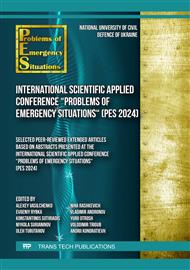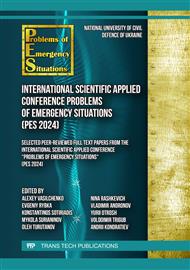[1]
A.W. Dorn, Eliminating Hidden Killers: How Can Technology Help Humanitarian Demining? Stability: International Journal of Security and Development. 8(1) (2019) 1–17.
DOI: 10.5334/sta.743
Google Scholar
[2]
M. Prem, M.E. Purroy, J.F. Vargas, Landmines: the Local Effects of Demining, TSE Working Paper, 1305 (2022) 22.
DOI: 10.31235/osf.io/3jzk6
Google Scholar
[3]
S. Ragimov, V. Sobyna, S. Vambol, V. Vambol, A. Feshchenko, A. Zakora, E. Strejekurov, V. Shalomov, Physical modelling of changes in the energy impact on a worker taking into account high-temperature radiation. Journal of Achievements in Materials and Manufacturing Engineering. 91(1) (2018) 27–33.
DOI: 10.5604/01.3001.0012.9654
Google Scholar
[4]
V. Andronov, B. Pospelov, E. Rybka, Development of a method to improve the performance speed of maximal fire detectors. Eastern-European Journal of Enterprise Technologies. 2/9(86) (2017) 32–37.
DOI: 10.15587/1729-4061.2017.96694
Google Scholar
[5]
B. Pospelov, E. Rybka, V. Togobytska, R. Meleshchenko, Yu. Danchenko, Construction of the method for semi-adaptive threshold scaling transformation when computing recurrent plots. Eastern-European Journal of Enterprise Technologies. 4/10 (100) (2019) 22–29.
DOI: 10.15587/1729-4061.2019.176579
Google Scholar
[6]
B. Pospelov, E. Rybka, R. Meleshchenko, S. Gornostal, S. Shcherbak, Results of experimental research into correlations between hazardous factors of ignition of materials in premises. Eastern-European Journal of Enterprise Technologies. 6/10 (90) (2017) 50–56.
DOI: 10.15587/1729-4061.2017.117789
Google Scholar
[7]
A. Melnichenko, M. Kustov, O. Basmanov, O. Karatieieva, N. Shevchuk, Devising a procedure to forecast the level of chemical damage to the atmosphereduring active deposition of dangerous gases. Eastern-European Journal of Enterprise Technologies. 1(10-115) (2022) 31–40.
DOI: 10.15587/1729-4061.2022.251675
Google Scholar
[8]
B. Pospelov, V. Andronov, E. Rybka, O. Krainiukov, N. Maksymenko, R. Meleshchenko, Yu. Bezuhla, I. Hrachova, R. Nesterenko, А. Shumilova, Mathematical model of determining a risk to the human health along with the detection of hazardous states of urban atmosphere pollution based on measuring the current concentrations of pollutants. Eastern-European Journal of Enterprise. 4/10 (106) (2020) 37–44.
DOI: 10.15587/1729-4061.2020.210059
Google Scholar
[9]
V. Tiutiunyk, H. Ivanets, I. Tolkunov, E. Stetsyuk, System approach for readiness assessment units of civil defense to actions at emergency situations. Naukovyi Visnyk Natsionalnoho Hirnychoho Universytetu. 1(163) (2018) 99–105
DOI: 10.29202/nvngu/2018-1/7
Google Scholar
[10]
O. Popov, A. Iatsyshyn, V. Kovach, V. Artemchuk, D. Taraduda, V. Sobyna, D. Sokolov, M. Dement, V. Hurkovskyi, K. Nikolaiev, T. Yatsyshyn, D. Dimitriieva, Physical features of pollutants spread in the air during the emergency at NPPs. Nuclear and Radiation Safety. 4(84) (2019) 88–98.
DOI: 10.32918/nrs.2019.4(84).11
Google Scholar
[11]
O. Kulakov, A. Katunin, M. Kustov, E. Slepuzhnikov, S. Rudakov, Investigation of Reliability of Emergency Shutdown of Consumers in Electric Power Systems of Explosive Hazardous Zones. 2022 IEEE 3rd KhPI Week on Advanced Technology (Conference Proceedings). (2022) 173–177.
DOI: 10.1109/khpiweek57572.2022.9916418
Google Scholar
[12]
B. Pospelov, V. Andronov, E. Rybka, V. Popov, A. Romin, Experimental study of the fluctuations of gas medium parameters as early signs of fire. Eastern-European Journal of Enterprise Technologies. 1/10 (91) (2018) 50–55.
DOI: 10.15587/1729-4061.2018.122419
Google Scholar
[13]
O. Popov, D. Taraduda, V. Sobyna, D. Sokolov, M. Dement, A. Pomaza-Ponomarenko, Emergencies at Potentially Dangerous Objects Causing Atmosphere Pollution: Peculiarities of Chemically Hazardous Substances Migration, Systems. Decision and Control in Energy. 298 (2020) 151–163.
DOI: 10.1007/978-3-030-48583-2_10
Google Scholar
[14]
O. Rybalova, S. Artemiev, M. Sarapina, B. Tsymbal, A. Bakhareva, O. Shestopalov, O. Filenko, Development of methods for estimating the environmental risk of degradation of the surface water state. Eastern-European Journal of Enterprise Technologies. 2/10 (92) (2018) 4–17.
DOI: 10.15587/1729-4061.2018.127829
Google Scholar
[15]
O. Popov, A. Iatsyshyn, V. Kovach, V. Artemchuk, D. Taraduda, V. Sobyna, D. Sokolov, M. Dement, T. Yatsyshyn, Conceptual approaches for development of informational and analytical expert system for assessing the NPP impact on the environment. Nuclear and Radiation Safety. 3 (79) (2018) 56–65.
DOI: 10.32918/nrs.2018.3(79).09
Google Scholar
[16]
R.W. Armstrong, W.L. Elban, Materials science and technology aspects of energetic (explosive) materials, Materials Science and Technology. Energetic (explosive) materials and deformation at high strain rates. 22(4) (2006) 381–395.
DOI: 10.1179/174328406x84049
Google Scholar
[17]
R. Kovalenko, A. Kalynovskyi, S. Nazarenko, B. Kryvoshei, E. Grinchenko, Z. Demydov, M. Mordvyntsev, R. Kaidalov, Development of a method of completing emergency rescue units with emergency vehicles. Eastern-European Journal of Enterprise Technologies. 4/3 (100) (2019) 54–62.
DOI: 10.15587/1729-4061.2019.175110
Google Scholar
[18]
D.P. Williams, V. Myers, M.S. Silvious, Mine Classification With Imbalanced Data. IEEE Geoscience and Remote Sensing Letters. 6(3) (2009) 528–532.
DOI: 10.1109/lgrs.2009.2021964
Google Scholar
[19]
Vl. Barannik, S. Sidchenko, N. Barannik, Val. Barannik, Development of the method for encoding service data in cryptocompression image representation systems, Eastern-European Journal of Enterprise Technologies, 3/9 (111) (2021) 103–115.
DOI: 10.15587/1729-4061.2021.235521
Google Scholar
[20]
N. Palka, M. Szala, E. Czerwinska, Characterization of prospective explosive materials using terahertz time-domain spectroscopy. Applied Optics. 55/17 (2016) 4575–4583.
DOI: 10.1364/ao.55.004575
Google Scholar
[21]
C. Yilmaz, H.T. Kahraman, S. Söyler, Passive mine detection and classification method based on hybrid model. IEEE Access. 6 (2018) 47870–47888.
DOI: 10.1109/access.2018.2866538
Google Scholar
[22]
T.J. Janssen, Explosive materials: Classification, composition and properties. Nova Science Publishers. (2011) 1–292.
Google Scholar
[23]
L.S. Yoo, J.H. Lee, Y.K. Lee, S.K. Jung, Y. Choi, Application of a drone magnetometer system to military mine detection in the demilitarized zone. Sensors. 21(9) (2021) 3175.
DOI: 10.3390/s21093175
Google Scholar
[24]
M.V. Kustov, O.М. Kulakov, A.A. Karpov, O.Ie. Basmanov, Yu.V., Mykhailovska, Model dyfraktsii elektromahnitnykh khvyl na vybukhonebezpechnykh predmetakh. Problemy nadzvychainykh sytuatsii. 2(38) (2023) 39–52.
Google Scholar
[25]
M. Kustov, A. Karpov, S. Harbuz, A. Savchenko, Effect of Physical and Chemical Properties of Explosive Materials on the Conditions of their Use. Key Engineering Materials. 952 (2023) 143–154.
DOI: 10.4028/p-0h8ung
Google Scholar
[26]
G.N. Shabanova, A.N. Korohodska, M.V. Kustov, M.Y. Ivashchenko, D.V. Taraduda, Barium-containing cement and concrete for protection against electromagnetic radiation. Functional Materialsthis. 28(2) (2021) 323–326.
Google Scholar
[27]
Yu. Otrosh, O. Semkiv, E. Rybka, A. Kovalov, About need of calculations for the steel framework building in temperature influences conditions. IOP Conference Series: Materials Science and Engineering. 708 (2019) 012065.
DOI: 10.1088/1757-899x/708/1/012065
Google Scholar
[28]
M.V. Kustov, V.D. Kalugin, V.V. Deineka, E.D. Slepuzhnikov, D.M. Deyneka, Radioprotective cement for long-term storage of nuclear waste. Voprosy Khimii i Khimicheskoi Tekhnologii. 2 (2020) 73–81.
DOI: 10.32434/0321-4095-2020-129-2-73-81
Google Scholar
[29]
Microwave power engineering: edited by E.C. Okress (in 3 vol.), Academic press, New York and London, 1968.
Google Scholar
[30]
L.D. Landau, E.M. Lifshitz, Electrodynamics of continuous media: translated by J.B. Skyes and J.S. Bell, Addison-Wesley, Boston, 1960.
Google Scholar



